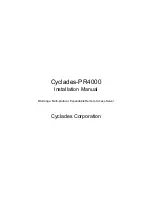
13
Special Shares, Users and Groups
When delivered, the Disk Server will have the following shares, groups and users. These pre-defined ob-
jects cannot be deleted, and only limited modifications may be performed
Shares
HDD1
•
Root folder, provided so the Administrator can backup all data on the Disk
Server by backing up the contents of this folder.
•
The
administrator
group ALWAYS has Read/Write access to this share.
public
•
By default, the
everyone
group has Read/Write access to this folder. This
may be changed.
•
This share can not be deleted.
Groups
everyone
•
This group cannot be deleted.
•
All users are members of this group, and cannot be removed from this group.
•
By default, this group has Read/Write access to the
public
share. This can
not be changed, but access to other shares can be granted or revoked.
administrator
•
This group ALWAYS has Read/Write access to ALL shares.
•
This group cannot be deleted.
•
The
admin
user cannot be removed from this group, but other users may be
added or deleted.
Users
admin
•
This user cannot be deleted.
•
The
admin
user is a member of the
administrator
group, and therefore has
Read/Write access to all shares.
•
By default, the
admin
user has no password, but a password can be as-
signed by the Disk Server Administrator. Assigning a password is
recommended.
guest
•
This user cannot be deleted.
•
The
guest
user is a member of the
everyone
group, and has the access
permissions allocated to the
everyone
group.
•
The properties of the
guest
user can NOT be changed.
Nested Shares
The Disk Server allows a folder inside a share to be a share.
This allows "nesting" of shares to any depth, just like the folders on your hard disk. If you use this feature,
you need to be aware of the following points:
•
In Windows'
Network Neighborhood
, all shares are listed on the same level - the "nesting" is completely
invisible.
•
When a user accesses a share, they will see only folders, never shares. Users cannot tell whether or
not a sub-folder is in fact a nested share.
•
Anyone with access to the outer share automatically has the same access rights to any inner shares.
You can NOT provide access to an outer share while preventing access to an inner share. So the most
sensitive data must be kept in the
outermost
share, not the innermost share. This is illustrated below.
Summary of Contents for NAS-1000
Page 1: ...i NAS 1000 Disk Server User s Guide ...
Page 4: ......















































